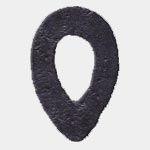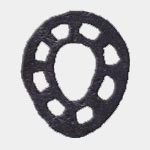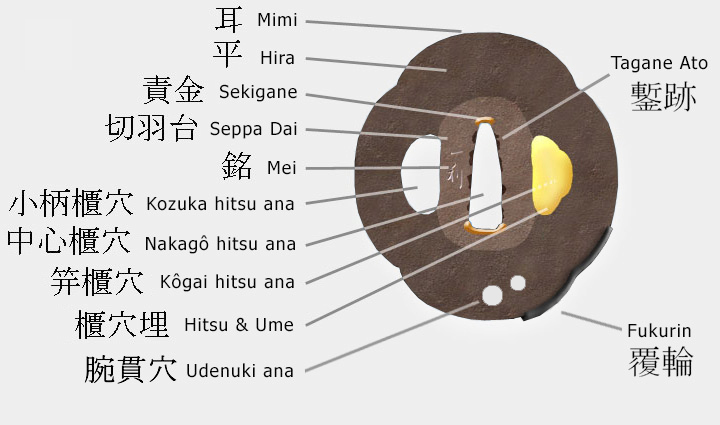
| Nihonto Kanji | Tosogu Kanji | Nenki & Kuni | Other Kanji | Kanji Help |
| Kanji for Tsuba |
The history of the Tsuba dates back nearly as far as the sword. It is not known exactly when they were
first created but we do know that removable Tsuba have been found in burial mounds that date back as
far as 300 - 400 AD. These Tsuba are referred to as Hôju ì and Tôran Kei |` Tsuba. Hôju means
Jewel and refers to the Sacred Jewel of Japan. Tôran Kei refers to an "Upside down egg" shape. These
early designs became the predecessors for all other tsuba designs for the next 1400 years. At the start of the Kôtô period ( around 1000 AD ) we saw the introduction of the Tachi tsuba and then a couple of hundred years after that, the Uchigatana tsuba. The Tachi were worn by the Samurai and designed for use on horseback whilst the Uchigatana were worn by common foot soldiers and were more for self defense purposes. Although there are some significant differences between the Tachi tsuba and the Uchigatana tsuba, the word 'tsuba' generally refers to the Uchigatana tsuba. Uchigatana tsuba are known as Kô Tosho à (sword smiths), Kô Katchushi Ãbht (armour smiths) and Ji Sukashi n§ tsuba. In regards to Kô Tosho and Kô Katchushi tsuba, it is generally thought that the Kô Tosho guards were introduced in or around the early Kamakura period and were for the most part, the product of sword smiths. Kô Katchushi are thought to be a secondary line of work produced by Armour makers. The general theory is that these guards came into production at either the end of the Kamakura period or the early Nambokuchô period. Both Kô Tosho and Kô Katchushi tsuba are also known as Mon-sukashi which refers to an openwork method used in their design. Shapes are pierced in negative silhouette into the flat body of the guard. The image is defined by the removal of the iron from the base. Ji Sukashi tsuba were developed it is thought, from around the Oei period ( 1394 ) to create tsuba that had a strong meaningful design whilst at the same time, reducing weight for use in fencing. The late Masayuki Sasano wrote "There are several similarities between the Ji-sukashi technique and Japanese ink painting, sumie, for example: the symbolic designs, the colour of the ink and there is a distinct relationship between the simple boldly emphasized openwork and the naive brush strokes and use of blank spaces of the ink paintings. A harmony between light and dark." I think Sasano sensei summed up Ji-sukashi tsuba marvelously. Kinko kodogu appeared in the late Nambokucho or early Muromachi periods. The exact date is unclear but it was quite early. Currently in collections both in Japan and abroad, there are many Ko Mino pieces from the mid Muromachi period and several from the early Muromachi period as well testifying to the existence of these soft metal fittings, rich in Shakudo and beautifully carved. Also around the time of the mid Muromachi period, Goto Yujo ( 1440 - 1512 ) brought to the world, the first known works using soft metals. This was to be the birth of Kinko. Goto Yujo's works brought a look to Tsuba and Kodogu never before seen, with High and Low relief, and for the first time bringing 3 dimension work to fittings that changed the look of tosogu for ever. From this time on until the Haitto-rei ( the banning of the wearing of swords in the ninth year of Meiji - 1876 ) tsuba took all shapes and forms, from the plain to the elaborate, the simple to the audacious. As time went on, it is thought that generally, just as in Nihonto, the quality of Tsuba waned as we raced towards the present day. There are of course many schools that excelled in the Edo period, including Akasaka, Higo, Yagyu, Goto etc. It is believed by some lovers of Iron tsuba that if the Yagyu and Akasaka schools had thrived in the Kôtô period and not the Edô period, then their status would have been elevated dramatically. Tsuba are a truely artful form and I hope you find the information on this page useful and enjoy their study as much as I do.
|
In regards to the development of shape then, we can follow the paths through the following images.
|
|
Hôju tsuba ì  |
Tôran kei |` 
|
Aoi tachi tsuba
|
Kara tsuba
|
Mokko tachi tsuba
|
With the development of the Uchigatana, the way the sword was worn changed, with the
cutting edge or Ha pointing upwards. This change also effected the way in which tsuba were fitted. You will notice
that the Nakago ana in now upside down compaired to that of the Tachi tsuba. Tachi of course were worn cutting edge down. |
Katchushi
|
Tosho
|
Ji sukashi
|
After this, the overall shapes in the Edo and late Edo periods took on many forms, including animals sleeping
or curled up, religous motifs, floral and plant forms, geometrics and many more. |
Maru gata
|
Mokko gata
|
Nademaru gata
|
|
Otafuku gata
|
Nade mokkô gata
|
Kaku gata
|
|
Otafuku gata sukashi
|
Maru gata kô sukashi
|
Maru gata sukashi
|
These are the various parts that make up the Tsuba. Below this, you will find a glossary that gives a brief
explanation of these names along with their Kanji.
|

Shown here are some of the more serious flaws one might encounter when looking at Kizu on tsuba. As with swords, all flaws
must be looked at with an open mmind. Some are too large and obvious to ignore but others might be tiny and lost in the
tsuba's aesthetic. Many of us find though that even the smallest flaw draws our eye and we cannot look past it. How we
each deal with these flaws is up to us as individuals. Click on the thumbnail to see lager images.
|
à |
Ategane |
A metal plug placed inthe Kozuka or Kogai-ana. Also refered to as Ume ( ) |
kÉ |
Chirimen |
AA crape paper finish. |
yè¨ |
Dote-mimi |
A rounded raised rim. |
¢Ö |
Fukurin |
An outer rim cover on a tsuba, usually in Shakado, Gold or some other soft metal. |
` (^) |
Gata (Kata) |
This means Shape, Maru Gata is Round Shape. |
½ |
Hira |
The Surface of the Tsuba. |
C |
Hitsu (-bitsu ) -ana |
Hole in the guard to accomodate the Kozuka and Koagai. Looking form the front, the Kozuka hole
is on the left side and the Kogai hole is on the right. |
nà (SS) |
Jigane (Shingane) |
The basic metal or base metal of a tsuba. |
n§ |
Ji Sukashi |
An open work method in which most of the iron of the flat body is removed to create the outline of a shape or shapes.. |
eG§ |
Kage-Sukashi |
Negative silhouette used in the Ji-Sukashi method. |
Ǩ |
Kan-mimi |
Thicker rounder raised rims. ( note; Thicker and rounder than Dote-mimi ) |
p¨ |
Kaku-mimi |
A squared rim. |
q |
Kamakura ( tsuba ) |
Thin Katchushi type sword guards dating from the late Muromachi period. The scenic motifs are created by shallow relief carving. |
Ѥ |
Kebori |
Line carving of consisten depth and and width. |
â C |
Kôgai-bitsu |
The hole for the Kôgai at the right of the tsuba. |
¬÷p¨ |
Koniku-kakumimi |
A slightly rounded square rim. |
¬¿C |
Kôzuka-bitsu |
The hole for a Kôzuka on the left side. |
¤ |
Kô Sukashi |
Small open work design. Kô literally means small. |
Û¨ |
Maru-mimi |
A rounded rim. |
Á |
Mei |
The tsuba smith's signature carved into the surface of the guard, usually beside the nakago-ana. |
¨ |
Mimi |
The Rim of the Tsuba |
ØZ |
Mokkô |
Lobed shapped. |
¶§ |
Mon-Sukashi |
An openwork method mainly used in Ko-Tosho and Ko-Katchushi sword gaurds. Shapes are pierced in negative silhouette into the flat body of the guard. The image is defined by the removal of the iron from the base. |
â |
Murasaki Sabi |
The patina of iron that has a grey-purplish colour. |
Û |
Nademaru |
Oval shapped |
ØZ^ |
Nade Mokkô Gata |
Lobed shapped on an oval base |
S |
Nakago-ana |
The hole in the center of the guard that passes over the tang of the sword. |
m |
Onin ( tsuba ) |
A sword guard on which the base plate is decorated with dot and line brass inlay. |
¨½ |
Otafuku |
Diamond Shapped |
¯ç |
Rusumoyo |
Part of a design that is missing and left to the imagination. |
Óà |
Sekigane |
A filler of Copper or Lead to to make the fit between the Tsuba and the Nakago snug. |
ØH |
Seppa |
Washers that are used for packing and can also decorate the front and back of the tsuba . |
ØHä |
Seppa Dai |
A flat base around the tang hole which seats the Seppa ( washers ). Seppa are set
on both sides of the tsuba. |
Ôº |
Shakudo |
An alloy comprising of Gold and copper. Polished, it is a rich black with a wonderful lustre. |
dü¨ |
Shiiremono |
lterally means "received commodity" and stands for mass produced items with a "brand name",
In Tosogu it generally refers to tsuba and fittings made just after the Meiji Restoration ( 1867/68 ) and sold to tourists on the docks
at Yokohama and Edo. These fittings are mostly low end but there are some better examples found. |
àt |
Shiroganeshi |
A smith working in gold, silver or soft metal alloys. |
ä(ÛÆ) |
Suemon ( suemon-zôgan ) |
High relief brass inlay. |
§Õ |
Sukashi tsuba |
Iron sword guards with openwork. There are two types. Mon-Sukashi and Ji-Sukashi. |
èSÕ |
Tagane Ato |
Literally 'punch marks'. These refer to the punch marks left around the tsuba's Nakago ana to help facilitate at tighter fit of the tsuba on the sword. |
S |
Tekkotsu |
Mixtures of iron of different qualities produce distinct texture variations that are visible to the rims of the guards. There are three main variations are fine, granular and linear. |
Õ (è\) |
Tsuba | Japanese Sword Guard |
ÆÚn |
Tsuchime Ji | Hammer marks on the surface of a tsuba. A surface that has a hammered appearance. |
ÅÔ¨ |
Uchikaeshi-mimi |
A bevelled raised rim. One of the typical features of Ko-Katchushi guards. |
rÑ |
Udenuki ana |
Two small holes at the bottom of a tsuba to pass a cord through. |
|
Ume |
See Ategane above |
Äè |
Yakite |
A method of finishing iron sword guards. A guard is heated to high temperature and then allowed to cool gradually. This method reveals the iron bones ( Tekkotsu ). Note: Yakite is also known as Yakinamashi īݵ. |
Rº |
Yamagane |
Unrefined Copper. This copper was made in times when the refining process was not as good as it is now. Other impurities are mixed in. The colur is deeper than modern Copper. |
z§ |
Yô Sukashi |
Positive silhouette used in the Ji-Sukashi method. |
ÛÆ |
Zôgan |
Inlay. Mostly brass or copper. |
Major tsuba ryuha
The major tsuba schools.
| Ôö | Akao | ¾¿ ¾í | Myôchin |
| Ôâ | Akasaka | ¾í I | Myôchin Ki |
| ¨ | Aoi | ìØ | Nanban |
| õO^lY | Bizen-Yoshirô | ÞÇ | Nara |
| B | Bushû | ¼_ | Nishigaki |
| ·B | Chôshû | MÆ | Nobuiye |
| åÜY | Daigorô | m (äm) | Onin |
| zO | Echizen | ö£ § | Owari sukashi |
| Ñ | Hayashi | ³ | Saotome |
| ã¡ | Gotô | u | Shimizu |
| ìã | Higo | ³¢í | Shôami |
| ½c | Hirata | Hc³¢í | Akita shôami |
| ½ÀéÛÆ | Heianjô Zôgan | ïó¢í | Aizu shôami |
| Fª¤@T | Hikone Bori Sôten | õO³¢í | Bizen shôami |
| @À | Hôan | ó¢í | Koshôami |
|
伊藤 |
Ito |
京正阿弥 |
Kyô shôami |
|
加賀 |
Kaga |
庄内 |
Shonai |
|
鏡師 |
Kagamishi |
藻柄子宗典 |
Soheishi Sôten |
|
加賀与四郎 |
Kaga-Yoshirô |
典 |
Sôten |
|
鎌倉 |
Kamakura |
太刀金具師 |
Tachi Kanagu-shi |
|
金山 |
Kanayama |
太刀師 |
Tachi sh |
|
金家 |
Kaneiye |
天法 |
Tempo |
|
甲冑師 |
Katchûshi |
土佐明珍 |
Tosa Myôchin |
|
記内 |
Kinai |
土佐 |
Tosa |
|
金工 |
Kinkô |
刀匠 |
Tôshô |
|
古美濃 |
Ko Mino |
埋忠 |
Umetada |
|
古刀匠 |
Ko Tôshô |
柳生 |
Yagyû |
|
京透 |
Kyô Sukashi |
山吉 |
Yamakichi |
|
美濃 |
Mino |
山吉兵 |
Yamakichibei |
|
水戸 |
Mito |
与四郎 |
Yoshiro |
Copyright 2006. Richard Turner